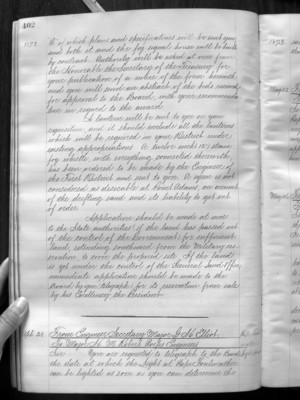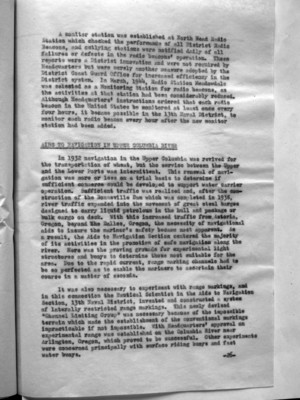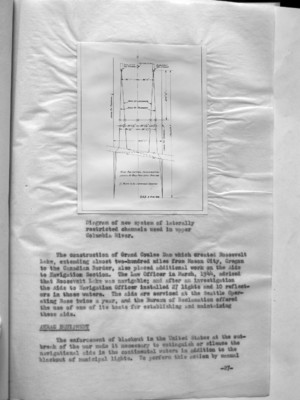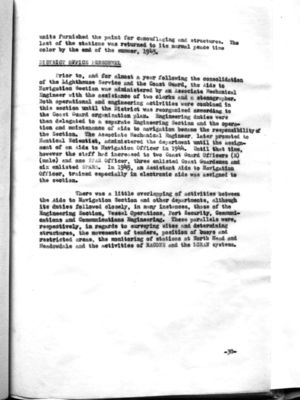Pages That Mention ???
Box 245 1893 to 95 YB lights CF repairs
14
Circular 23 Major Jack ??? 20 Aug. 1895 J.C. Post, U.S.A., Engineer 13th L.H. Dist., Portland, Oreg. Sir: Please report the experience in your district up to date with the new 4th order Funck-Heap Lamp, and Submit any suggestions you would offer with a view to improvement. Respectfully, John ??? Captain, Corps of Engineers, U.S.A., Engineer Secretary.
1870-73 Lighthouse Board Annual Reports
49
1873.
"C" of which plans and specifications will be sent you and both it and the fog-signal house will be built by contract. Authority will be asked at once from the Honorable the Secretary of the Treasury for your publication of a notice of the form herewith and you will send an abstract of the bids received for approval to the Board, with your recommendation in regard to the award.
A lantern will be sent to you on your requisition, and it should include all the lanterns which will be required in your District under existing appropriations. A twelve inch (12") steam fog-whistle, with everything connected therewith, has been ordered to be made by the Engineer of the First District and sent to you. A ??? is not considered as desirable at Point Adams, on account of the drifting sand and its liability to get out of order.
Application should be made at once to the State authorities (if the land has passed out of the control of the Government) for sufficient land, extending southward from the Military reservation, to cover the proposed site. If the land is yet under the control of the General Land Office, immediate application should be made to the Board by you (telegraph) for its reservation from sale by his Excellency, the President.
_____________________________________________________
Apl. 28. From Engineer Secretary Major G. H. Elliot. To Major H. M. Robert. Corps Engineers.
Sir: You are requested to telegraph to the Board the date at which the Light at Cape Foulweather can be lighted as soon as you can determine the
Coast Guard District narrative histories 1945
9
A monitor station was established at North Head Radio Station which checked the performance of all District Radio Beacons, and outlying stations were notified daily of all failures or defects in the radio beacons' operation. These reports were a District innovation and were not required by Headquarters but were merely another measure adopted by the District Coast Guard Office for increased efficiency in the District system. In March, 1944, Radio Station Meadowdale was ??? as a Monitoring Station for radio beacons, as the activities at that station had been considerably reduced. Although Headquarters' instructions ordered that each radio beacon in the United States be monitored at least once every four hours, it became possible in the 13th Naval District, to monitor each radio beacon every hour after the new monitor station had been added.
AIDS TO NAVIGATION IN UPPER COLUMBIA RIVER
In 1932 navigation in the Upper Columbia was revived for the transportation of wheat, but the servies between the Upper and Lower Ports was intermittent. This renewal of navigation was more or less on a trial basis to determine if sufficient commerce could be developed to support water carrier operation. Sufficient traffic was realized and, after the construction of the Bonneville Dam which was completed in 1938, river traffic expanded into the movement of great steel barges designed to carry liquid petroleum in the hull and package or bulk cargo on deck. With this increased traffic from Astoria, Oregon, beyond The Dalles, Oregon, the necessity of navigational aids to insure the mariner's safety became most apparent. As a result, the Aids to Navigation Section centered the majority of its activities in the promotion of safe navigation along the river. Here was the proving grounds for experimental light structures and buoys to determine those most suitable for the area. Due to the rapid current, range marking channels had to be so perfected as to enable the mariners to ascertain their course in a matter of seconds.
It was also necessary to experiment with range markings, and in this connection the Nautical Scientist in the Aide to Navigation Section, 13th Naval District, invented and constructed a system of laterally restricted range markings. This newly devised "Channel Limiting Group" was necessary because of the impossible terrain which made the establishment of the conventional markings impracticable if not impossible. With Headquarters' approval an experimental range was established on the Columbia River near Arlington, Oregon, which proved to be successful. Other experiments were concerned principally with surface riding buoys and fast water buoys.
-26-
10
(image)
Diagram of new system of laterally restricted channels used in upper Columbia River.
The construction of Grand Coulee Dam which created Roosevelt Lake, extending almost two-hundred miles from Mason City, Oregon to the Canadian Border, also placed additional work on the Aide to Navigation Section. The Law Officer in March, 1944, advised that Roosevelt Lake was navigable; and after an investigation the Aids to Navigation Officer installed 27 lights and 10 reflectors in those waters. The aids are serviced at the Seattle Operating Base twice a year, and the Bureau of Reclamation offered the use of one of its boats for establishing and maintaining these aids.
ANRAC ??? EQUIPMENT
The enforcement of blackout in the United States at the outbreak of the war made it necessary to extinguish or silence the navigational aids in the continental waters in addition to the blackout of municipal lights. To perform this action by manual
-27-
13
units furnished the paint for camouflaging and structures. The last of the stations was returned to its normal peace time color by the end of the summer, 1945.
DISTRICT OFFICE PERSONNEL
Prior to, and for almost a year following the consolidation of the Lighthouse Service and the Coast Guard, the Aids to Navigation Section was administered by an Associate Mechanical Engineer with the assistance of two clerks and a stenographer. Both operational and engineering activities were combined in this section until the District was reorganized according to the Coast Guard organization plan. Engineering duties were then delegated to a separate Engineering Section and the operation and maintenance of aids to navigation became the responsibility of the Section. The Associate Mechanical Engineer, later promoted to Nautical Scientist, administered the department until the assignment of an Aids to Navigation Officer in 1944. Until that time, however the staff had increased to two Coast Guard Officers (R) (male) and one SPAR Officer, three enlisted Coast Guardsmen and six enlisted SPARS. In 1945, an Assistant Aids to Navigation Officer, trained especially in electronic aids was assigned to the section.
There was a little overlapping of activities between the Aids to Navigation Section and other departments, although its duties followed closely, in many instances, those of the Engineering Section, Vessel Operations, Port Security, Communications and Communications Engineering. These parallels were, respectively, in regards to surveying sites and deteraining??? structures, the movements of tenders, position of buoys and restricted areas, the monitoring of stations at North Head and Meadowdale and the activities of RACONS and the LORAN systems.
-30-




